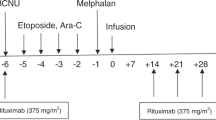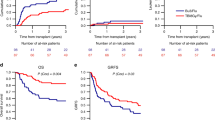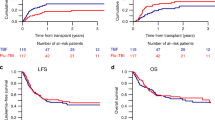Abstract
Patients with refractory/relapsing lymphoma are rarely cured by chemotherapy. High-dose chemotherapy (HDC) for tumor debulking followed by reduced-intensity conditioning (RIC) hematopoietic stem-cell transplantation (HSCT) has been advocated as a concept. We previously treated 10 patients (group A) with BEAM chemotherapy followed by delayed RIC HSCT at day 28. We now report on the subsequent 11 patients receiving BEAM followed immediately by fludarabine/total body irradiation and allogeneic HSCT (group B), and compare the outcome to group A patients. Non-hematological toxicity before engraftment was comparable, only gut toxicity was higher in group B. Days in aplasia, days on antibiotics and length of hospital stay were significantly longer in group A. Cumulative incidence of acute (GvHD) ⩾grade II and incidence of chronic GvHD were lower in group B. At last follow-up, seven patients in group A were alive, with six of them in complete remission. In group B, nine patients were alive, seven of them in complete remission. No significant difference in estimated 3-year overall survival was seen. These data challenge the initial concept of debulking first and delaying allogeneic RIC HSCT. Allogeneic HSCT with standard BEAM conditioning is a valid alternative for patients with resistant/relapsed lymphoma, which might be considered earlier in the disease course.
This is a preview of subscription content, access via your institution
Access options
Subscribe to this journal
Receive 12 print issues and online access
$259.00 per year
only $21.58 per issue
Buy this article
- Purchase on Springer Link
- Instant access to full article PDF
Prices may be subject to local taxes which are calculated during checkout



Similar content being viewed by others
References
Linch DC, Winfield D, Goldstone AH, Moir D, Hancock B, McMillan A et al. Dose intensification with autologous bone-marrow transplantation in relapsed and resistant Hodgkin's disease: results of a BNLI randomised trial. Lancet 1993; 341: 1051–1054.
McCann JC, Kanteti R, Shilepsky B, Miller KB, Sweet M, Schenkein DP . High degree of occult tumor contamination in bone marrow and peripheral blood stem cells of patients undergoing autologous transplantation for non-Hodgkin's lymphoma. Biol Blood Marrow Transplant 1996; 2: 37–43.
Kuittinen T, Nousiainen T, Halonen P, Mahlamaki E, Jantunen E . Prediction of mobilisation failure in patients with non-Hodgkin's lymphoma. Bone Marrow Transplant 2004; 33: 907–912.
Butcher BW, Collins Jr RH . The graft-versus-lymphoma effect: clinical review and future opportunities. Bone Marrow Transplant 2005; 36: 1–17.
Peniket AJ, Ruiz de Elvira MC, Taghipour G, Cordonnier C, Gluckman E, de Witte T et al. An EBMT registry matched study of allogeneic stem cell transplants for lymphoma: allogeneic transplantation is associated with a lower relapse rate but a higher procedure-related mortality rate than autologous transplantation. Bone Marrow Transplant 2003; 31: 667–678.
Milpied N, Fielding AK, Pearce RM, Ernst P, Goldstone AH . Allogeneic bone marrow transplant is not better than autologous transplant for patients with relapsed Hodgkin's disease. European Group for Blood and Bone Marrow Transplantation. J Clin Oncol 1996; 14: 1291–1296.
Khouri IF, Saliba RM, Giralt SA, Lee MS, Okoroji GJ, Hagemeister FB et al. Nonablative allogeneic hematopoietic transplantation as adoptive immunotherapy for indolent lymphoma: low incidence of toxicity, acute graft-versus-host disease, and treatment-related mortality. Blood 2001; 98: 3595–3599.
Nagler A, Slavin S, Varadi G, Naparstek E, Samuel S, Or R . Allogeneic peripheral blood stem cell transplantation using a fludarabine-based low intensity conditioning regimen for malignant lymphoma. Bone Marrow Transplant 2000; 25: 1021–1028.
Branson K, Chopra R, Kottaridis PD, McQuaker G, Parker A, Schey S et al. Role of nonmyeloablative allogeneic stem-cell transplantation after failure of autologous transplantation in patients with lymphoproliferative malignancies. J Clin Oncol 2002; 20: 4022–4031.
Robinson SP, Goldstone AH, Mackinnon S, Carella A, Russell N, de Elvira CR et al. Chemoresistant or aggressive lymphoma predicts for a poor outcome following reduced-intensity allogeneic progenitor cell transplantation: an analysis from the Lymphoma Working Party of the European Group for Blood and Bone Marrow Transplantation. Blood 2002; 100: 4310–4316.
Maris MB, Storb R . Allogeneic hematopoietic cell transplantation as consolidation immunotherapy of cancer after autologous transplantation. Acta Haematol 2005; 114: 221–229.
Papadopoulos KP, Noguera-Irizarry W, Hesdorffer CS . Tandem transplantation in lymphoma. Bone Marrow Transplant 2001; 28: 529–535.
Carella AM, Cavaliere M, Lerma E, Ferrara R, Tedeschi L, Romanelli A et al. Autografting followed by nonmyeloablative immunosuppressive chemotherapy and allogeneic peripheral-blood hematopoietic stem-cell transplantation as treatment of resistant Hodgkin's disease and non-Hodgkin's lymphoma. J Clin Oncol 2000; 18: 3918–3924.
Buser AS, Heim D, Bucher C, Tichelli A, Gratwohl A, Passweg JR . High-dose chemotherapy using BEAM for tumor debulking without stem cell support followed by early allogeneic reduced intensity conditioning transplantation to induce a graft-versus-lymphoma effect in patients with high risk or refractory lymphoma. Bone Marrow Transplant 2004; 33: 1011–1014.
Hale GA, Phillips GL . Allogeneic stem cell transplantation for the non-Hodgkin's lymphomas and Hodgkin's disease. Cancer Treat Rev 2000; 26: 411–427.
Przepiorka D, van Besien K, Khouri I, Hagemeister F, Samuels B, Folloder J et al. Carmustine, etoposide, cytarabine and melphalan as a preparative regimen for allogeneic transplantation for high-risk malignant lymphoma. Ann Oncol 1999; 10: 527–532.
Atkinson K, Horowitz MM, Gale RP, Lee MB, Rimm AA, Bortin MM . Consensus among bone marrow transplanters for diagnosis, grading and treatment of chronic graft-versus-host disease. Committee of the international bone marrow transplant registry. Bone Marrow Transplant 1989; 4: 247–254.
Przepiorka D, Weisdorf D, Martin P, Klingemann HG, Beatty P, Hows J et al. 1994 Consensus Conference on Acute GVHD Grading. Bone Marrow Transplant 1995; 15: 825–828.
Goldberg J, Jacobsohn DA, Zahurak ML, Vogelsang GB . Gastrointestinal toxicity from the preparative regimen is associated with an increased risk of graft-versus-host disease. Biol Blood Marrow Transplant 2005; 11: 101–107.
Collin MP, Hart DN, Jackson GH, Cook G, Cavet J, Mackinnon S et al. The fate of human Langerhans cells in hematopoietic stem cell transplantation. J Exp Med 2006; 203: 27–33.
Damiani D, Stocchi R, Masolini P, Michelutti A, Sperotto A, Geromin A et al. Dendritic cell recovery after autologous stem cell transplantation. Bone Marrow Transplant 2002; 30: 261–266.
Galy A, Rudraraju S, Baynes R, Klein J . Recovery of lymphocyte and dendritic cell subsets after autologous CD34+ cell transplantation. Bone Marrow Transplant 2000; 25: 1249–1255.
Mills W, Chopra R, McMillan A, Pearce R, Linch DC, Goldstone AH . BEAM chemotherapy and autologous bone marrow transplantation for patients with relapsed or refractory non-Hodgkin's lymphoma. J Clin Oncol 1995; 13: 588–595.
Ferrara F, Viola A, Copia C, Schiavone EM, Celentano M, Pollio F et al. Therapeutic results in patients with relapsed diffuse large B cell non-Hodgkin's lymphoma achieving complete response only after autologous stem cell transplantation. Hematol Oncol 2006; 24: 73–77.
Freytes CO, Loberiza FR, Rizzo JD, Bashey A, Bredeson CN, Cairo MS et al. Myeloablative allogeneic hematopoietic stem cell transplantation in patients who experience relapse after autologous stem cell transplantation for lymphoma: a report of the International Bone Marrow Transplant Registry. Blood 2004; 104: 3797–3803.
Cull GM, Haynes AP, Byrne JL, Carter GI, Miflin G, Rebello P et al. Preliminary experience of allogeneic stem cell transplantation for lymphoproliferative disorders using BEAM-CAMPATH conditioning: an effective regimen with low procedure-related toxicity. Br J Haematol 2000; 108: 754–760.
Faulkner RD, Craddock C, Byrne JL, Mahendra P, Haynes AP, Prentice HG et al. BEAM-alemtuzumab reduced-intensity allogeneic stem cell transplantation for lymphoproliferative diseases: GVHD, toxicity, and survival in 65 patients. Blood 2004; 103: 428–434.
Acknowledgements
ASB is supported by research grants from the Novartis Stiftung and the Swiss National Science Foundation (Grant PBBSB-108506). This work is supported by research grants from the Swiss Cancer League (Grant BIL OCS 01597-08-2004) and the Swiss National Science Foundation (Grant PBBSB-107328). The study was supported by the Swiss National Research Foundation (Grant 3200B0-106105). We thank Lothar Hambach for valuable discussions and critically reviewing the paper.
Author information
Authors and Affiliations
Corresponding author
Rights and permissions
About this article
Cite this article
Buser, A., Stern, M., Bucher, C. et al. High-dose chemotherapy using BEAM without autologous rescue followed by reduced-intensity conditioning allogeneic stem-cell transplantation for refractory or relapsing lymphomas: a comparison of delayed versus immediate transplantation. Bone Marrow Transplant 39, 335–340 (2007). https://doi.org/10.1038/sj.bmt.1705597
Received:
Revised:
Accepted:
Published:
Issue Date:
DOI: https://doi.org/10.1038/sj.bmt.1705597
Keywords
This article is cited by
-
Tandem autologous-allo-SCT is feasible in patients with high-risk relapsed non-Hodgkin’s lymphoma
Bone Marrow Transplantation (2013)
-
Double allogeneic hematopoietic SCT as a rescue therapy for poor-risk hematological malignancies
Bone Marrow Transplantation (2010)
-
Impaired B-cell reconstitution in lymphoma patients undergoing allogeneic HSCT: an effect of pretreatment with rituximab?
Bone Marrow Transplantation (2008)
-
BEAC or BEAM high-dose chemotherapy followed by autologous stem cell transplantation in non-Hodgkin’s lymphoma patients: comparative analysis of efficacy and toxicity
Annals of Hematology (2008)



